An enterprise architecture (EA) is a conceptual blueprint for conducting enterprise analysis, design, planning, and implementation, using a comprehensive approach at all times, for the successful development and execution of strategy.
The purpose of enterprise architecture is to determine how an organization can most effectively achieve the current and future objectives of its business goals. Each enterprise architecture involves governing principles that drive an ongoing discussion about business strategy and how it can be expressed through IT. Enterprise architects are professionals who manage each structure to ensure that IT systems are aligned with ongoing business strategies and standards.
An enterprise architecture framework (EA framework) defines how to create and use an enterprise architecture, which provides principles and practices for creating and using the architecture description of a system. It provides tools and approaches that help enterprise architects to optimize different architecture domains across the enterprise the often fragmented legacy of processes (both manual and automated) into an integrated environment that is responsive to change and supportive of the delivery of the business strategy. Typically, the architecture domains are listed below based on four basic interrelated areas of specialization:
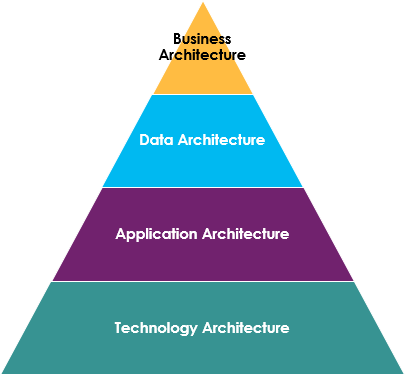
Architecture Framework is a prefabricated structure that organizes the system architecture of an enterprise into complementary projections called Views. These industry-standard enterprise Architecture Frameworks include three different types of frameworks:
The EA Template Framework is any specific method or process for collecting, managing or using the information that it describes.; rather, it is an ontology whereby a schema for organizing architectural artifacts (in other words, design documents, specifications, and models) is used to take into account both who the artifact targets (for example, business owner and builder) and what particular issue (for example, data and functionality) is being addressed.
The Zachman Framework
Zachman Framework is an enterprise ontology and is a fundamental structure for Enterprise Architecture which provides a way of viewing an enterprise and its information systems from different perspectives and showing how the components of the enterprise are related. The Zachman Framework goes beyond IT. It offers structural connections into any aspect of an enterprise.
The rows of Zachman Framework focus on describing the enterprise from six viewpoint perspectives of the stakeholders. These six perspectives are based on English language interrogatives ‘what’, ‘where’, ‘who’, ‘when’, ‘why’, and ‘how’ (known as W5H).
The columns of the framework consist of a set of artifacts that are a description of the enterprise from a specific viewpoint of a group of stakeholders. The stakeholders are generally grouped as planners, owners, designers (architects), implementers, sub-constructors, users, or sometimes represented as viewpoints: scope context, business concepts, system logic, technology, physics, component assemblies, and operations classes.
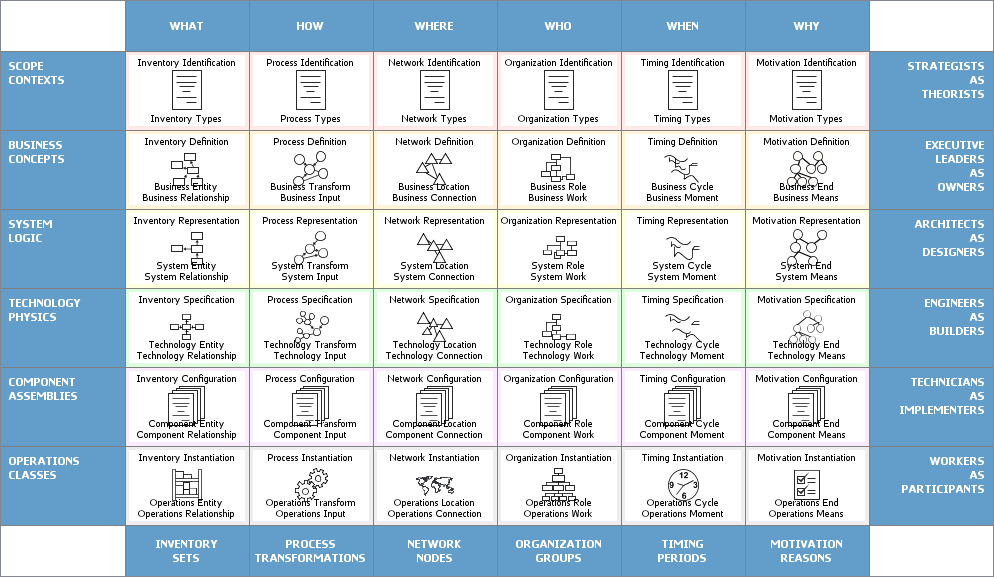
The framework enables complex subjects to be distilled into systematic categories in the column headers, using these six basic questions (known as 5WH). The answers to these questions will differ, depending on the perspective or audience (represented in the rows).
An EA content framework defines the artifacts that EA should produce. In TOGAF, the ADM defines the method including the process, steps, and guidelines for developing the artifacts and deliverables for each of the development phases.
The Open Group Architectural Framework (TOGAF) was first developed in 1995 created and owned by The Open Group, which was based on the Department of Defense’s Technical Architecture Framework for Information Management. It is one of the most common framework structures in business today and accounts for over 80 percent of the entire business framework structure. TOGAF contains all the needed pieces for a powerful framework. It has a common vocabulary to use, recommended standards and compliance methods, suggested software and tools, and even a method to define best practices.
TOGAF is often viewed as more an overarching process. The details and methods contained within TOGAF help guide businesses through any step of business organization. A key element of TOGAF is the Architecture Development Method (ADM) which specifies a process for developing enterprise architecture.
The TOGAF Framework consists of six important parts as shown in the following figure:

The DoD Architecture Framework (DoDAF) is the industry-standard Enterprise Architecture Framework for defense and aerospace applications. It defines how to organize the specification of enterprise architectures for the U.S. Department of Defense (DoD) applications. All major DoD weapons and information technology system procurements are required to document their enterprise architectures using the view products prescribed by the DoDAF. Although DoDAF is primarily focused on defense applications, it can also be applied to commercial systems. The DoDAF provides a foundational framework for developing and representing architecture descriptions that ensure a common denominator for understanding, comparing, and integrating architectures across organizational, joint, and multinational boundaries.
DoDAF establishes data element definitions, rules, and relationships and a baseline set of products for consistent development of systems, integrated, or federated architectures. It is well suited to large systems and systems-of-systems (SoSs) with complex integration and interoperability issues. The objective of DoDAF is to concretely define models and concepts that are usable in the DoD’s core processes:
Version 2.0 of the DoDAF had the following specific goals:
Version 2.0 viewpoints:
In DoDAF V2.0, architectural viewpoints are composed of data that has been organized to facilitate understanding. To align with ISO Standards, where appropriate, the terminology has changed from Views to Viewpoint (e.g., the Operational View is now the Operational Viewpoint).
All Viewpoint (AV) – Describes the overarching aspects of architecture context that relate to all viewpoints.
Capability Viewpoint (CV) – New in DoDAF V2.0. It articulates the capability requirements, the delivery timing, and the deployed capability.
Data and Information Viewpoint (DIV) – New in DoDAF V2.0. Articulates the data relationships and alignment structures in the architecture content for the capability and operational requirements, system engineering processes, and systems and services.
Operational Viewpoint (OV) – Includes the operational scenarios, activities, and requirements that support capabilities.
Project Viewpoint (PV) – New in DoDAF V2.0. Describes the relationships between operational and capability requirements and the various projects being implemented. The Project Viewpoint also details dependencies among capability and operational requirements, system engineering processes, systems design, and services design within the Defense Acquisition System process.
Services Viewpoint (SvcV) – New in DoDAF V2.0. Presents the design for solutions articulating the Performers, Activities, Services, and their Exchanges, providing for or supporting operational and capability functions.
Standards Viewpoint (StdV) – Renamed from Technical Standards View. Articulates the applicable operational, business, technical, and industry policies, standards, guidance, constraints, and forecasts that apply to capability and operational requirements, system engineering processes, and systems and services.
Systems Viewpoint (SV) – Articulates, for legacy support, the design for solutions articulating the systems, their composition, interconnectivity, and context providing for or supporting operational and capability functions.
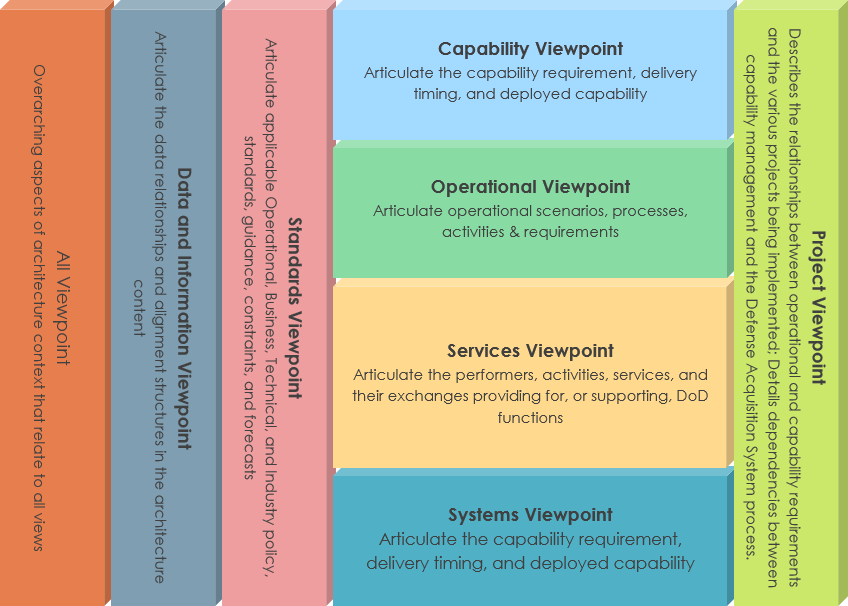
The Federal Enterprise Architectural Framework (FEA) is one of the newest attempts to create a solid structure for organizations. The US Federal Government developed it in 2006. It helps organize the myriad of different agencies and organizations under its control.
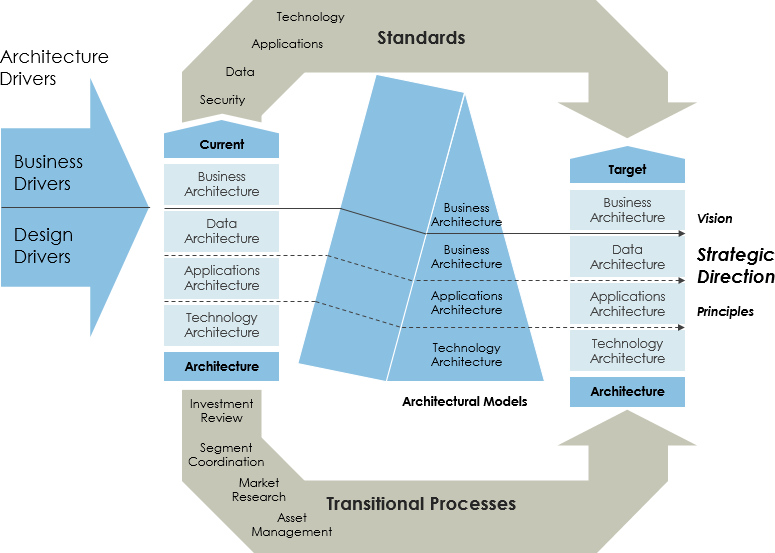
The Ministry of Defense Architecture Framework (MODAF) is an internationally recognized enterprise architecture framework developed by the Ministry of Defence (MOD) to support defense planning and change management activities. It does this by enabling the capture and presentation of information in a rigorous, coherent and comprehensive way that aids the understanding of complex issues.
MODAF provides a coherent set of rules and templates, known as ‘views’, that, when populated, provide a graphical and textual visualization of the business area being investigated. Each view offers a different perspective on the business to support different stakeholder interests.
The views are divided into 7 categories:
To ensure the coherence between the views, MODAF is underpinned by a model that defines the relationship between all the data in all the views. This model is called the MODAF.
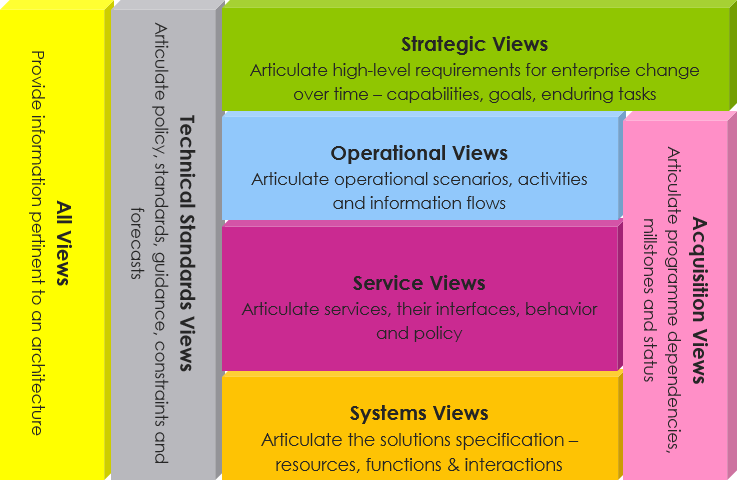
UPDM is the Unified Profile for DoDAF / MODAF /NAF 3.0. It has been realized by the OMG (Object Management Group) to provide modeling support conforming to the USA Department of Defense Architecture Framework (DoDAF) and the UK Ministry of Defence Architecture Framework (MODAF).
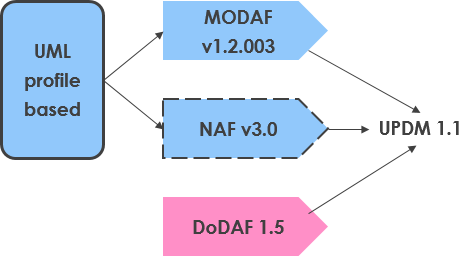
The NAF is designed to ensure that architectures developed adhering to it can be understood, compared, justified and related across many organizations, including NATO and other National Defence initiatives. The aim of the NATO Architecture Framework Version 4 (NAFv4) is to provide a standard for developing and describing architectures for both military and business use. The objectives of the framework are to:
NAF 4.0 defines Viewpoints, Views and Architecture Descriptions. It details a two-dimensional classification scheme for the standardized architecture viewpoints, this serves as the baseline for any NAF-Compliant architecture effort. To aid architects, these viewpoints are organized into a logical and consistent manner and presented as a “grid”. This ‘grid’ structure, represents the various ‘subjects of concern’ (rows) and ‘aspects of concern’ (columns), as shown below:
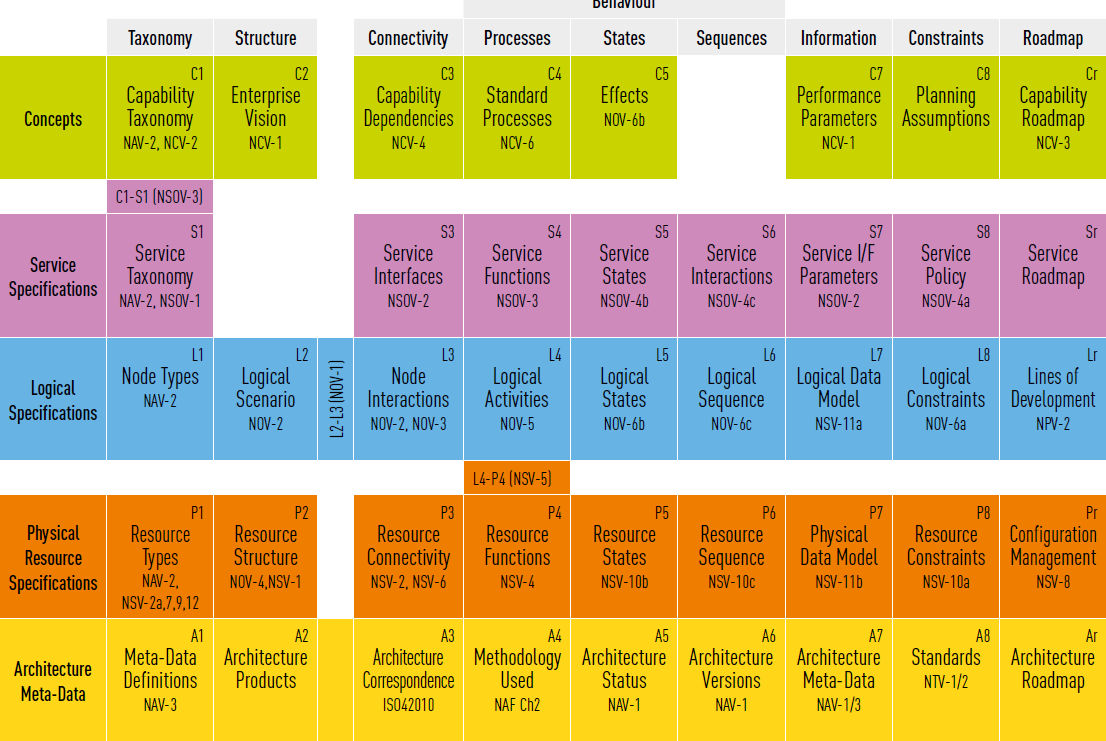
The Unified Architecture Framework® (UAF®) is based on the Unified Profile for DoDAF and MODAF™ (UPDM™). UAF defines ways of representing an enterprise architecture that enables stakeholders to focus on specific areas of interest in the enterprise while retaining sight of the big picture. UAF meets the specific business, operational and systems-of-systems integration needs of commercial and industrial enterprises as well as the U.S. Department of Defense (DoD), the UK Ministry of Defence (MOD), the North Atlantic Treaty Organization (NATO) and other defense organizations.
UAF provides a set of rules to enable users to create consistent enterprise architectures (as models) based on generic enterprise and system concepts with rich semantics. These models then become the repositories from which various views can be extracted. UAF supports current DoDAF/MODAF/NAF requirements and can evolve to meet future needs: